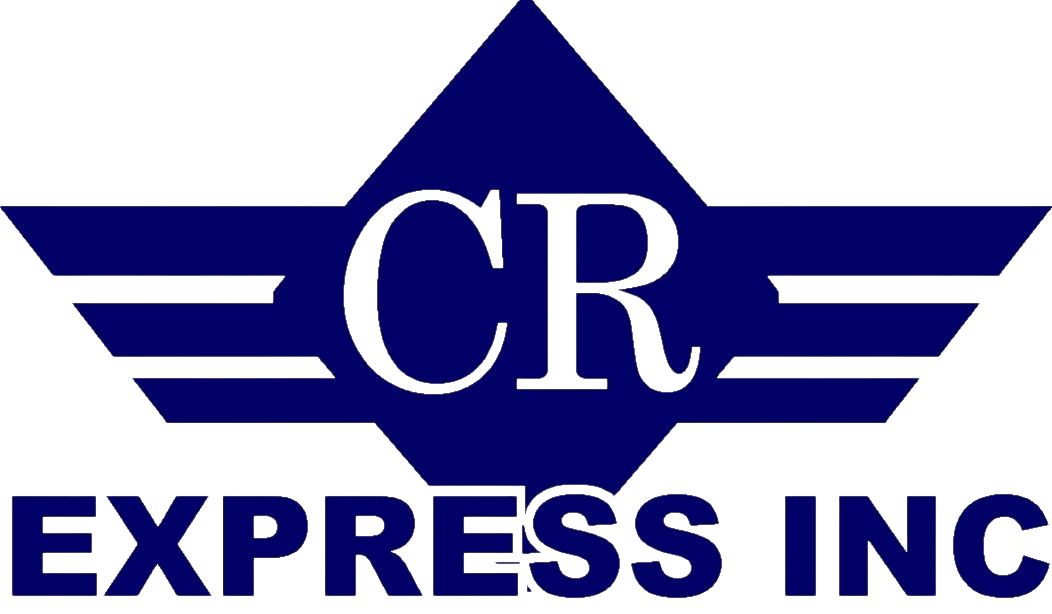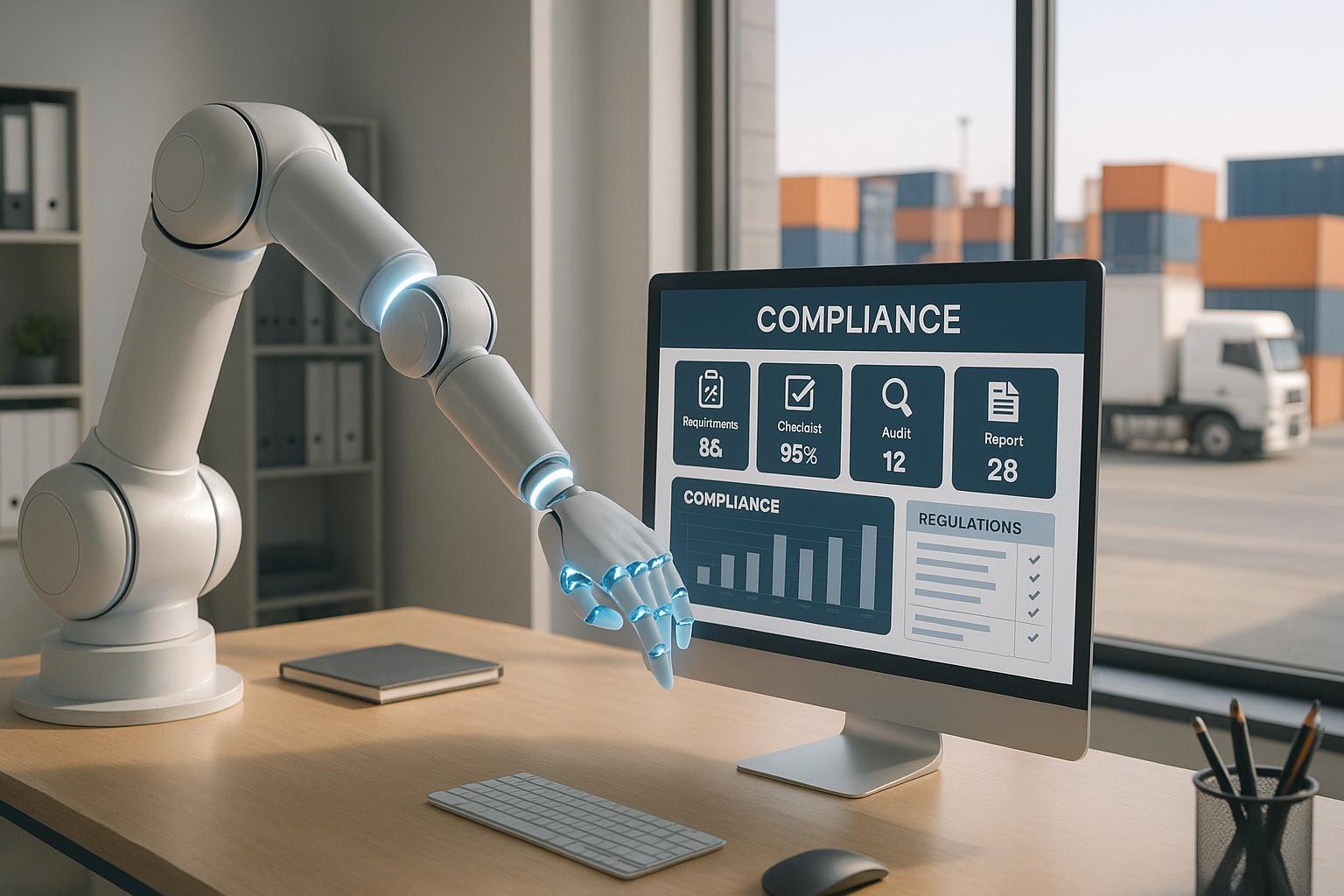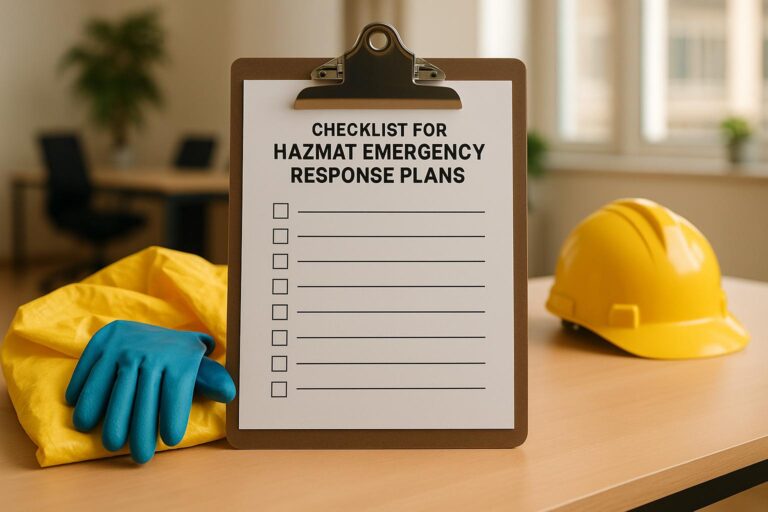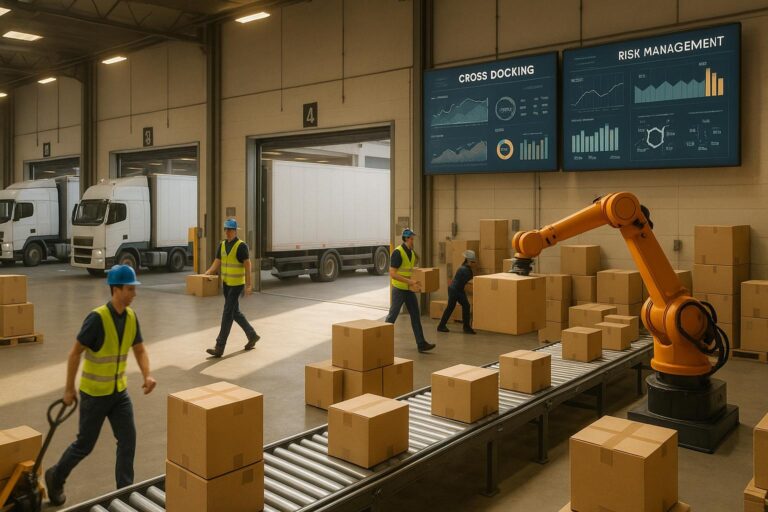Logistics compliance is complex and time-consuming, burdened by strict regulations from agencies like the TSA, DOT, and EPA. Robotic Process Automation (RPA) solves this by automating repetitive tasks such as documentation, data validation, and audit trail creation. This reduces human error, saves time, and lowers costs.
Key Takeaways:
- Automation Benefits: Companies using RPA save millions annually by replacing manual tasks with bots.
- Common Applications: RPA creates shipping documents, validates data, and ensures compliance with hazardous materials, customs, and GDP regulations.
- Real-world Impact: One company automated 22,000 shipment documents monthly, saving 2,200 work hours.
RPA doesn’t just ensure compliance – it also improves efficiency, allowing employees to focus on higher-value tasks. Whether handling hazardous goods, temperature-sensitive shipments, or international cargo, RPA makes compliance faster, more accurate, and less labor-intensive.
Automation for Efficient Carrier Onboarding & Compliance
Compliance Processes That RPA Can Automate
RPA takes the hassle out of manual compliance tasks in logistics, turning them into efficient, automated workflows. By managing repetitive, rule-based processes, RPA bots help reduce errors, cut costs, and ensure regulatory compliance through automated tasks like documentation, data validation, and audit trail management. Here’s a closer look at how RPA simplifies key compliance processes in logistics.
Automated Documentation and Reporting
Creating shipping documents, customs declarations, and compliance reports manually often leads to delays and mistakes. RPA bots eliminate these issues by automatically pulling data and filling in the required fields, ensuring every document meets regulatory standards before submission. This not only speeds up processes but also boosts accuracy.
These bots handle the entire lifecycle of documentation. They pull shipment details from integrated systems to create essential documents like bills of lading, customs declarations, and hazardous materials paperwork. For shipments requiring extra care – such as temperature-sensitive or high-value goods – RPA ensures all compliance information is captured quickly and correctly. Additionally, RPA simplifies regulatory reporting by compiling reports, tracking deadlines, and ensuring timely submission to relevant agencies. For example, one logistics company automated the preparation and distribution of over 22,000 shipment documents each month, saving more than 2,200 hours in administrative work.
Data Validation and Error Prevention
Manual data entry is prone to errors that can result in regulatory breaches, fines, or shipping delays. RPA bots tackle this by validating shipment data against regulatory databases and internal systems, significantly reducing the risk of errors. These bots perform real-time checks to ensure shipment classifications are correct and data remains consistent across platforms. This automated process is particularly helpful for shipments with specialized requirements, such as hazardous materials or temperature-sensitive goods, ensuring compliance is maintained without fail.
Audit Trail Creation and Management
Every action performed by an RPA bot is automatically logged, creating detailed, timestamped audit trails that are invaluable during internal reviews or regulatory inspections. These searchable logs provide a clear record of compliance steps, making it easy to generate detailed reports on how shipments were processed. Real-time monitoring of bot activities adds another layer of assurance, allowing management to spot and address potential compliance gaps before they become bigger problems. For complex shipments, such as those requiring TSA-approved handling, these audit trails offer a transparent record of compliance activities, ensuring smooth operations and peace of mind.
Benefits of Using RPA for Compliance
RPA (Robotic Process Automation) goes beyond simple automation, offering measurable advantages that significantly strengthen logistics compliance. For full-service providers managing diverse shipment types and navigating complex regulations, RPA becomes a strategic tool that boosts operational performance.
Cost Reduction and Efficiency Gains
By automating repetitive tasks, RPA turns compliance from a costly necessity into a strategic advantage. It slashes manual labor costs and speeds up processes. For example, one provider reduced a 15-minute manual task to just 21 seconds, replacing 302 full-time positions with 200 automations and saving over $6 million annually. Another provider optimized pre-pickup communications, cutting margin decay by nearly 30% – equating to $648,000 in annual savings. Similarly, automating freight forwarding compliance checks saved 87% of working hours. These time and cost efficiencies free up resources, allowing compliance teams to focus on strategic initiatives. For companies like CR Express, which handles everything from airport transfers to pharmaceutical logistics requiring GDP compliance, this shift leads to better service quality and faster response times.
Scalability for Different Shipment Types
RPA adapts seamlessly to varying shipment volumes and complexities, eliminating the need for additional staff. Whether managing hazardous materials with strict safety protocols or handling high-value or temperature-sensitive goods, RPA ensures compliance checks and documentation are applied consistently. For instance, only 9% of businesses report full compliance with the EU’s Corporate Sustainability Due Diligence Directive, while 30% admit they’re lagging behind. CR Express, with its TSA-approved transportation services and bonded warehousing facilities, benefits from RPA’s ability to maintain consistent compliance across all service lines, regardless of shipment type.
Client and Partner Confidence
Error-free compliance builds trust with clients and regulators. By reducing human errors that can lead to shipment delays or regulatory breaches, RPA ensures accurate documentation and proactive risk management. For CR Express, which prides itself on being a "Trusted Partner for Logistics Solutions" with 26 years of experience, automated compliance guarantees flawless execution of critical tasks like maintaining GDP standards for pharmaceuticals and managing customs documentation. Additionally, RPA minimizes costly warehouse errors, such as last-mile misloads (24%), label inaccuracies (22%), and packaging mistakes (18%), which can cost up to $389,000 annually. Confidence in automation is growing, with a recent survey revealing that one-quarter of logistics businesses have already implemented RPA, while two-thirds plan to adopt it soon.
sbb-itb-c0b8770
How CR Express Can Implement RPA for Compliance
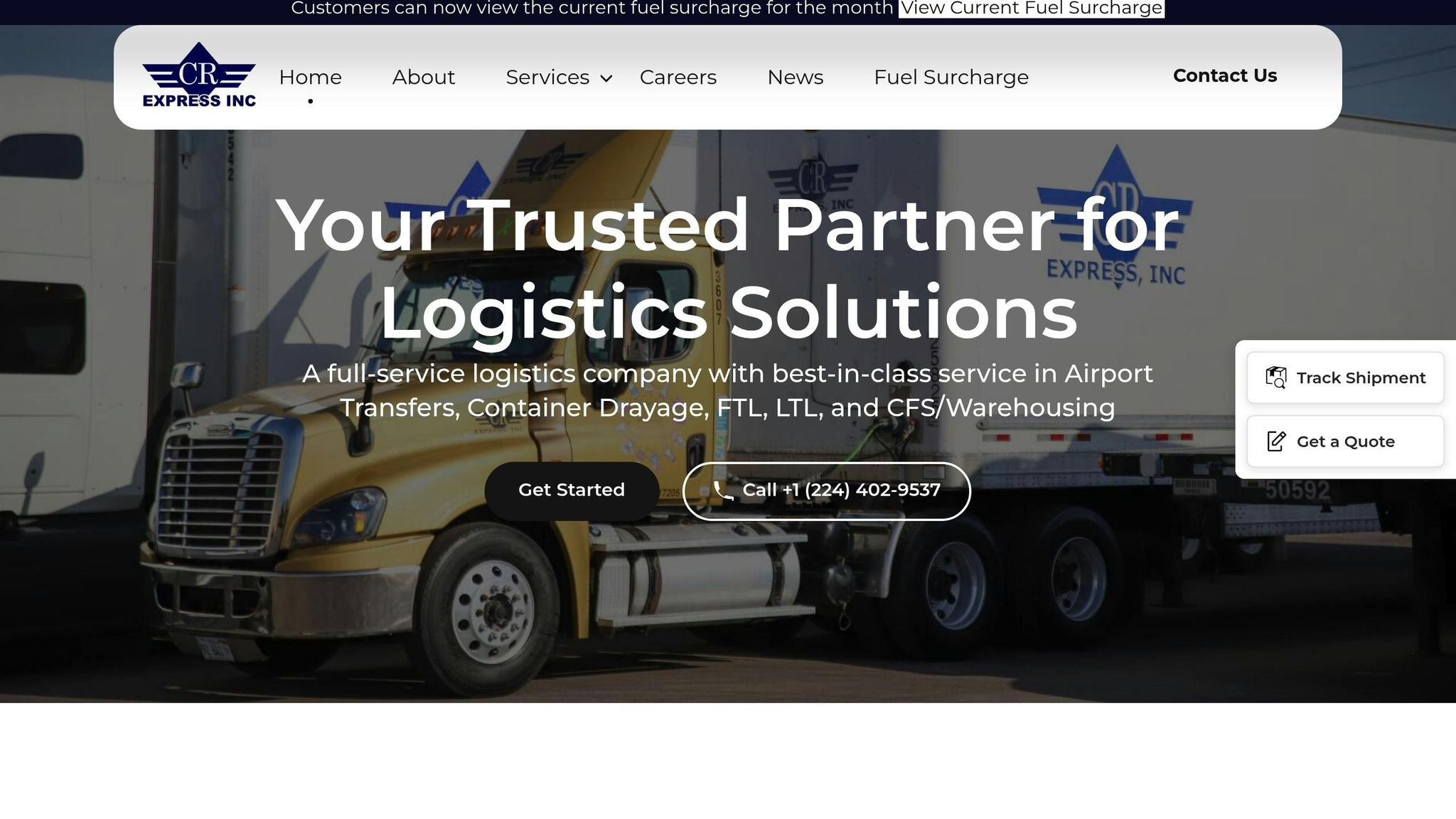
CR Express has the opportunity to integrate Robotic Process Automation (RPA) into its compliance workflows using its established technology platforms. With real-time visibility and automated reporting already in place, the company is well-positioned to streamline compliance processes with RPA.
Evaluating Current Compliance Workflows
The first step for CR Express is to carefully map out all compliance-related processes across its diverse service offerings. This involves identifying repetitive, rule-based tasks in key areas such as bonded warehousing, hazardous goods documentation, pharmaceutical logistics compliance (GDP), and TSA-approved transportation procedures. Particular attention should be given to critical compliance areas like customs management for its Class III Customs Bonded Warehouse, export documentation for air cargo, and temperature-controlled storage records for healthcare shipments.
To make this mapping effective, each step of the process – from data entry to final approval – should be documented. For instance, in the 280,000-square-foot bonded warehouse, this includes tracking cargo duration, customs clearance, and oversight records. For GDP compliance, the focus should be on temperature-controlled storage logs, cold chain logistics documentation, and regulatory reporting.
The goal here is to pinpoint bottlenecks and error-prone tasks that are ripe for automation. By analyzing where delays occur, manual mistakes happen, or significant human effort is required, CR Express can identify prime candidates for RPA. Key areas for automation might include customs declaration data entry, generating standardized compliance reports, or validating shipping manifests against regulatory requirements.
Selecting RPA Tools and Platforms
Once workflows are mapped, the next step is selecting the right RPA platform. CR Express should prioritize platforms that integrate seamlessly with its existing technology, such as warehouse management systems, transport management systems, and real-time visibility tools. Given the company’s use of third-party solutions like Samsara for safety and efficiency, compatibility with current systems is essential to ensure smooth data flow and operational continuity.
The chosen platform should address CR Express’s unique compliance needs. This includes automating tasks for Customs Bonded Warehouse operations, GDP documentation for pharmaceutical logistics, hazardous goods transport records, and international export/import paperwork. Additionally, the platform must enhance automated reporting by providing detailed, unalterable audit trails for all compliance-related activities.
Scalability and flexibility are also critical. CR Express operates across a wide range of services, including full truckload (FTL), less-than-truckload (LTL), air cargo, intermodal transport, warehousing, and cross-docking. The RPA platform must handle varying shipment types, fluctuating volumes, and changing regulatory environments while maintaining consistent performance.
Pilot Programs and Gradual Expansion
With workflows mapped and a platform selected, CR Express can begin with a pilot program. Starting with a high-impact yet low-complexity process is ideal. For example, automating customs documentation or hazardous goods reporting could be an excellent choice, as these processes are repetitive, rule-based, and prone to human error. The pilot should aim to demonstrate measurable improvements quickly.
Clear success metrics are essential for evaluating the pilot. CR Express should track benchmarks such as error reduction, time savings, and compliance improvements. For example, if the pilot focuses on customs documentation, metrics might include cutting processing time from hours to minutes, eliminating data entry errors, and ensuring audit trail completeness.
If the pilot is successful, CR Express can expand RPA implementation gradually. The company should prioritize additional compliance areas based on factors like process complexity, transaction volume, and potential return on investment. A phased rollout might include automating compliance for temperature-controlled goods requiring GDP adherence or high-value shipments needing TSA-approved handling. Lessons from the pilot can guide this expansion, ensuring a smooth transition.
Ongoing monitoring and refinement are key to long-term success. CR Express should continuously track RPA performance, gather feedback from compliance teams and frontline staff, and make adjustments as needed. This iterative approach allows the company to build expertise, minimize disruptions, and maintain its high standards for logistics operations while scaling automation effectively.
Conclusion: RPA as a Business Tool for Logistics Compliance
RPA is reshaping the logistics industry by taking over regulatory tasks and streamlining compliance processes. Companies that have adopted RPA report significant savings in both time and costs, while also minimizing human errors. These advantages make it an essential tool for managing the increasing complexity of regulatory requirements.
With customs rules, transportation safety standards, and cargo regulations constantly evolving, manual processes often fall short. RPA steps in by automating tasks like documentation, data validation, and creating audit trails, allowing logistics providers to stay ahead of these challenges.
Beyond compliance, RPA offers efficiency gains that free up employees to focus on higher-value, strategic work. This is especially beneficial for logistics providers handling diverse shipments. Whether it’s temperature-sensitive pharmaceuticals, hazardous materials, or high-value goods, RPA systems can adjust compliance checks and documentation to meet specific regulatory needs, all without additional manual input.
For CR Express, RPA simplifies compliance across its operations, from airport transfers to bonded warehousing. It automates TSA-approved documentation, customs paperwork, and specialized handling for various cargo types, making regulatory processes smoother and more reliable.
FAQs
How does RPA help reduce errors and ensure compliance in logistics?
Robotic Process Automation (RPA) is transforming the way logistics companies handle compliance by taking over repetitive tasks like data entry, document verification, and regulatory reporting. By automating these processes, RPA minimizes human errors, ensuring accuracy in critical areas such as customs paperwork and transportation regulation compliance.
RPA doesn’t just boost accuracy – it also simplifies workflows, helping logistics providers keep up with ever-changing regulations while saving both time and money. For example, automated systems can instantly check shipment details against regulatory standards, reducing the risk of fines or delays. On top of that, RPA improves record-keeping, making audits and compliance reviews faster and far less stressful.
What challenges can arise when using RPA for compliance in logistics, and how can businesses address them?
Implementing Robotic Process Automation (RPA) in logistics to enhance compliance isn’t without its challenges. Businesses often face hurdles like steep initial setup costs, difficulties integrating RPA with existing systems, and resistance from employees who may be hesitant to embrace new technology. These obstacles can slow down adoption and reduce the overall impact of the solution.
To address these challenges, companies can take a phased approach. Begin by automating straightforward, repetitive tasks to build momentum and confidence. Providing comprehensive training to employees ensures they feel equipped and supported during the transition. Choosing RPA tools that align seamlessly with current systems can also reduce friction. Additionally, collaborating with an experienced logistics provider, such as CR Express, can ease the process. Their deep understanding of regulatory requirements and expertise in maintaining accurate documentation can help businesses navigate compliance with greater ease.
How can logistics companies evaluate the success and ROI of using RPA for compliance?
Logistics companies can gauge the effectiveness and return on investment (ROI) of robotic process automation (RPA) in compliance by focusing on a few key performance indicators. One important metric is error rates – compare documentation errors before and after implementing RPA to see how much accuracy has improved. Another is time efficiency – track how long compliance tasks, like regulatory reporting, take after automation to measure time saved. Lastly, consider cost reductions, which can include lower labor costs and fewer fines or penalties due to better compliance.
Take, for instance, services like bonded warehousing or TSA-approved transportation. These areas demand impeccable documentation to meet regulatory standards. RPA can play a critical role here by ensuring requirements are consistently met while reducing both errors and delays.
